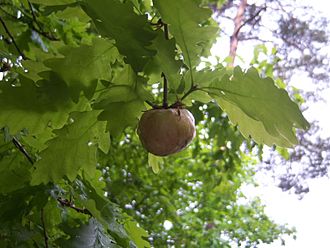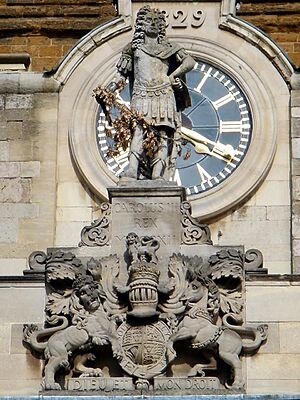Oak Apple Day facts for kids
Oak Apple Day, also known as Royal Oak Day or Restoration Day, was once a public holiday in England, Wales, and Ireland. It was celebrated every year on May 29th to remember when the monarchy was brought back to England in 1660.
The holiday celebrates Charles II of England, who returned to London on his 30th birthday, May 29, 1660, to become king. This event is called the Restoration. Although it's no longer an official holiday, some towns in England still celebrate it with fun traditions.
Contents
The Story Behind the Holiday
The celebration is linked to an exciting event in King Charles II's life. Nine years before he became king, Charles was on the run after losing the Battle of Worcester in 1651. To escape from enemy soldiers, he famously hid inside a large oak tree. The tree's thick leaves kept him safe and hidden.
Because an oak tree saved the future king, it became a symbol of his return to power.
In 1660, the English Parliament created a law that made May 29th a public holiday. It was a day for people to give thanks for the king's safe return and the end of a difficult period. A similar law was passed in Ireland in 1662.
How People Celebrated
The main tradition of Oak Apple Day was to wear a sprig of oak leaves or an oak apple. An oak apple is a round, ball-like growth found on oak trees, created by wasps.
Wearing the oak showed you supported the king. But if you were caught without your oak leaves, you might be in for some trouble!
In some places, people who didn't wear oak could be pelted with bird's eggs or playfully whipped with stinging nettles. In Sussex, the day was nicknamed "Pinch-bum Day" because people would pinch anyone not wearing oak. In Essex, it was called "Bumping Day."
In the village of Upton Grey, Hampshire, bell-ringers would place a large oak branch over the church door and smaller branches on every house's gate for good luck.
Is Oak Apple Day Still a Holiday?
Oak Apple Day stopped being an official public holiday in 1859. However, many of its traditions have lived on in local communities and at certain institutions.
For example, the Royal Hospital Chelsea, a home for army veterans in London, still celebrates the day as Founder's Day. King Charles II founded the hospital in 1681.
Modern Celebrations
Today, several towns across England keep the spirit of Oak Apple Day alive.
- Fownhope, Herefordshire: The Heart of Oak Society holds a parade. People march through the village with sticks decorated with flowers and oak leaves, following a brass band.
- Northampton: At All Saints' Church, a statue of King Charles II is decorated with a garland of oak leaves every year at noon.
- St Neot, Cornwall: The village holds a procession led by the local vicar. An old oak branch is thrown from the church tower, and a new one is pulled up to replace it. Villagers wear a sprig of new oak in the morning and a different plant, called "Boys Love," in the afternoon.
- Other Towns: Celebrations also take place in Upton-upon-Severn in Worcestershire, Great Wishford in Wiltshire, and Aston-on-Clun in Shropshire.
These events show how a piece of history from hundreds of years ago can still be a fun part of community life today.
See also
- Push penny
- Saint George's Day in England



